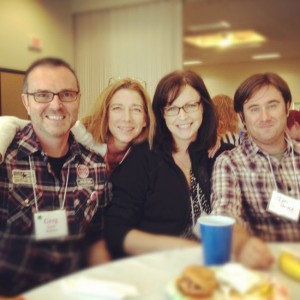Guest writer Jim Bruce is an intersex activist who recently relocated from San Francisco to Missoula. I had the chance to carpool with Jim and his girlfriend to the PFLAG Regional Conference a couple of weeks ago and was struck by my own lack of knowledge about the ‘I’ that is so often not included in the LGBTQ movement.
While there are similarities between the communities, there are also very real differences. However, gender diversity is a value we hold in common, and it serves the LGBTQ movement well to become educated about our friends and allies in the intersex movement.
October 26 is Intersex Awareness Day (IAD). IAD came about when the Intersex Society of North America partnered with a transgender group, Transexual Menace, to picket the American Association of Pediatrics (AAP) annual conference in Boston for recognition and awareness on October 26, 1996.
So, what is intersex? Let’s start with the basics: Almost everything you learned back in high school sex education class is wrong. An estimated one in 2,000 babies is born with a reproductive or sexual anatomy and/or chromosome pattern that doesn’t fit the typical definitions of male or female. The conditions that cause these variations are sometimes grouped under the terms “intersex” or differences of sex development (DSD).
These conditions include androgen insensitivity syndrome, congenital adrenal hyperplasia, Klinefelter’s syndrome, Turner’s syndrome, hypospadias, and many others. (For more information about specific conditions or anatomy, see the Intersex Society of North America). Intersex people or people with DSDs have lived in all cultures throughout history. These conditions occur naturally, if rarely, and individuals and societies have developed different ways of responding to this reality.
People ask me why I do this work, and my reply stated simply is because I was born with genitals that frightened my parents and caregivers. I was forced to endure damaging normalizing procedures. I want to see tomorrow’s generation grow up as they are with all futures possible and their bodies untouched by the prejudices I ran into as an infant.
Part of the reason why people feel shame around intersex conditions or alternatively have never heard about intersex conditions is because they are systemically not discussed in the mainstream medical community.
In the United States, beginning in the 1950s, doctors surgically altered infants and children with intersex conditions and conducted other medical interventions intended to make their bodies appear more typical. Their families were told to keep their conditions a secret, sometimes even from the child. Sometimes doctors didn’t tell the parents or the children the full truth about the child’s condition. At that time, doctors believed that early surgical intervention and secrecy would help the child develop a “normal” gender identity as either a boy or a girl.
Advocates for Informed Choice (AIC), understands that the medical treatment of children with DSDs or intersex conditions raises several legal and ethical issues. There are important questions about whether current medical practices meet legal standards for informed consent. Some parents of children born with intersex conditions have reported feeling pressured to make quick decisions, often without complete information about the risks of surgery and the uncertainty of outcomes. Many parents feel that their child’s emotional health is a major factor in their decisions, yet are not given access to specialists in children’s mental health and development.
Physicians may try to ease parents’ fears by downplaying the risks, but parents who learn after the fact about the doubts surrounding elective genital surgery may be dissatisfied. Legal scholars and ethicists have also questioned the process for making surgical decisions on behalf of children with intersex conditions. The ethical and clinical uncertainty that exists in this area raises important questions about whether the current model of decision-making is legally valid. Additional legal questions come up if surgical treatment may result in loss of fertility for the child. No United States Court has ruled on these issues in a published opinion.
Founded in 2006, Advocates for Informed Choice (AIC) undertakes a coordinated strategy of legal advocacy for the rights of children with intersex conditions or DSDs working with parents, doctors, attorneys, and intersex activists. More recently, AIC advocated for intersex/DSD rights with government and international agencies, including the Office of Human Research Protection, the State Department, and the United Nations High Commissioner for Refugees. To learn more about the intersex community visit Advocates for Informed Choice’s website.
Jim Bruce is the Communications and Youth Coordinator for Advocates for Informed Choice (AIC). Jim has been an advocate for intersex kids since he moved to the San Francisco Bay in 1998 at age 21. He was profiled in the documentary XXXY. He recently relocated to Missoula to be with his girlfriend, Montana-based musician, Eden Atwood – fellow intersex activist and co-founder of AIC’s Interface Project. Jim can be reached at jim@aiclegal.org.
Caitlin Copple is Pride Foundation’s Regional Development Organizer in Montana. Email Caitlin.
